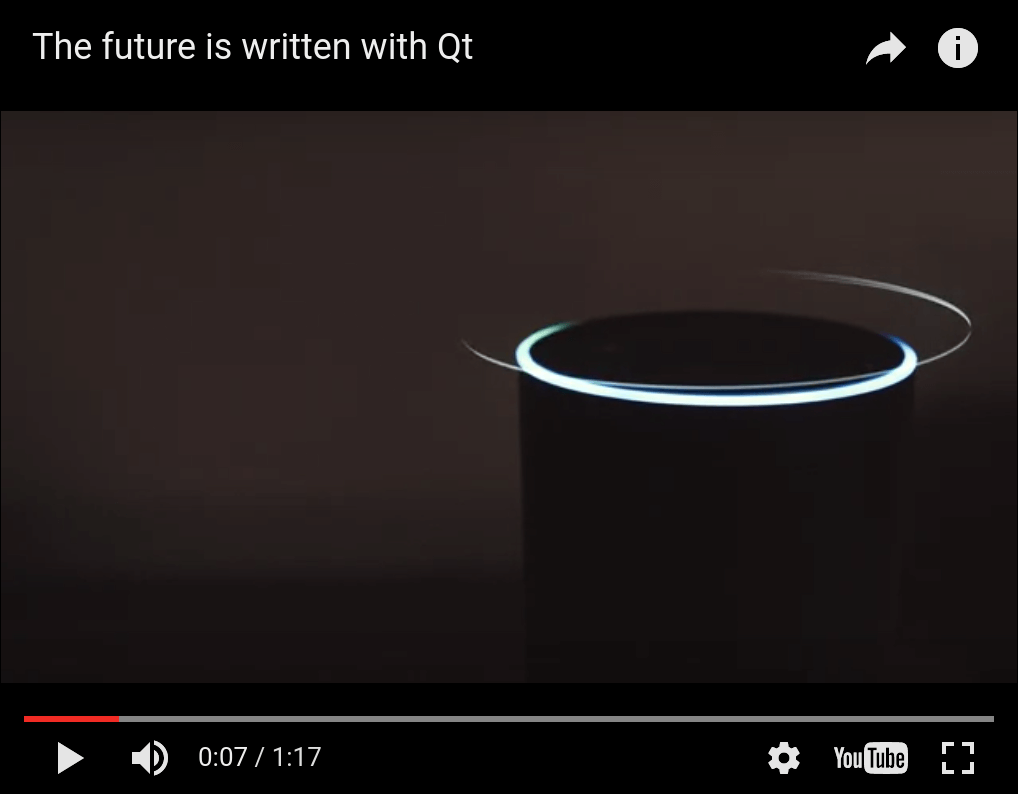WebEngine Widgets视频播放器示例
使用QWebEngineView显示全屏视频。

视频播放器演示了如何使用QWebEngineView支持HTML5视频的全屏播放。
全屏API是一个跨浏览器的JavaScript API,允许网页请求其中某个HTML元素占据用户的整个屏幕。它通常用于通过<video>元素进行全屏视频播放,但实际上可以用来在全屏模式下显示任何HTML内容。Qt WebEngine支持此API,但默认情况下是禁用的。此示例显示了切换该功能的步骤,包括
- 在QWebEngineSettings中启用它。
- 通过创建一个新的全屏窗口来处理QWebEnginePage::fullScreenRequested信号。
- 显示一个通知弹出窗口以确保用户知道有内容正在全屏显示。
运行示例
要从Qt Creator运行示例,请打开欢迎模式并从示例中选择示例。有关更多信息,请访问构建和运行示例。
概述
一旦启动,示例程序将创建一个带有QWebEngineView的正常(非全屏)窗口,显示嵌入的YouTube视频播放器。然后您可以点击全屏切换按钮(右下角)进入全屏模式。这还应显示一个居中的通知叠加层,通知您可以通过按Esc键退出全屏模式。
在实践中,进入全屏模式涉及创建一个带有单独的QWebEngineView实例的新全屏窗口,并将QWebEnginePage从正常窗口的QWebEngineView迁移到这个新的QWebEngineView。退出全屏模式将撤销迁移。
示例代码分为三个类,分别是MainWindow、FullScreenWindow和FullScreenNotification。类MainWindow和FullScreenWindow各自负责管理一个顶层窗口,而FullScreenNotification负责样式化和动画化通知框。启动时创建了一个MainWindow,整个程序运行期间都存在,而每次进入全屏模式时都创建一个新FullScreenWindow。
MainWindow类声明
一个MainWindow是一个具有QWebEngineView作为中心窗口部件的QMainWindow
#include "fullscreenwindow.h" #include <QMainWindow> #include <QWebEngineView> #include <QWebEngineFullScreenRequest> class MainWindow : public QMainWindow { Q_OBJECT public: explicit MainWindow(QWidget *parent = nullptr); private slots: void fullScreenRequested(QWebEngineFullScreenRequest request); private: QWebEngineView *m_view; QScopedPointer<FullScreenWindow> m_fullScreenWindow; };
MainWindow类定义
在构造函数中,我们首先将QWebEngineView设置为中心窗口部件
MainWindow::MainWindow(QWidget *parent) : QMainWindow(parent) , m_view(new QWebEngineView(this)) { setCentralWidget(m_view);
然后我们配置Qt WebEngine以支持全屏API
m_view->settings()->setAttribute(QWebEngineSettings::FullScreenSupportEnabled, true);
如果没有这一行,全屏切换按钮将不可用(灰色),因为页面上的JavaScript可以检测到我们的浏览器不支持全屏模式。
接下来,我们将fullScreenRequested信号连接到我们的槽函数
connect(m_view->page(), &QWebEnginePage::fullScreenRequested, this, &MainWindow::fullScreenRequested);
每当页面上的JavaScript想要进入或退出全屏模式时,都会触发这个信号。如果没有处理这个信号(但仍然将FullScreenSupportEnabled属性设置为true),则切换按钮将可用,但点击它不会有任何效果,因为JavaScript的全屏请求将被拒绝。
最后,我们将一些HTML(请参阅示例中包含的webenginewidgets/videoplayer/data/index.html)加载到我们的QWebEngineView中
m_view->load(QUrl(QStringLiteral("qrc:/index.html")));
MainWindow的第二部分是处理全屏请求
void MainWindow::fullScreenRequested(QWebEngineFullScreenRequest request) { if (request.toggleOn()) { if (m_fullScreenWindow) return; request.accept(); m_fullScreenWindow.reset(new FullScreenWindow(m_view)); } else { if (!m_fullScreenWindow) return; request.accept(); m_fullScreenWindow.reset(); } }
当进入全屏模式时,我们创建一个新的FullScreenWindow,并在退出时删除它。
FullScreenWindow类声明
FullScreenWindow是一个包含QWebEngineView和FullScreenNotification的QWidget
#include <QWidget> QT_BEGIN_NAMESPACE class QWebEngineView; QT_END_NAMESPACE class FullScreenNotification; class FullScreenWindow : public QWidget { Q_OBJECT public: explicit FullScreenWindow(QWebEngineView *oldView, QWidget *parent = nullptr); ~FullScreenWindow(); protected: void resizeEvent(QResizeEvent *event) override; private: QWebEngineView *m_view; FullScreenNotification *m_notification; QWebEngineView *m_oldView; QRect m_oldGeometry; };
FullScreenWindow类定义
构造函数负责隐藏普通窗口(同时保存其几何形状)并显示新的FullScreenWindow
FullScreenWindow::FullScreenWindow(QWebEngineView *oldView, QWidget *parent) : QWidget(parent) , m_view(new QWebEngineView(this)) , m_notification(new FullScreenNotification(this)) , m_oldView(oldView) , m_oldGeometry(oldView->window()->geometry()) { m_view->stackUnder(m_notification); auto exitAction = new QAction(this); exitAction->setShortcut(Qt::Key_Escape); connect(exitAction, &QAction::triggered, [this]() { m_view->triggerPageAction(QWebEnginePage::ExitFullScreen); }); addAction(exitAction); m_view->setPage(m_oldView->page()); setGeometry(m_oldGeometry); showFullScreen(); m_oldView->window()->hide(); }
调用QWebEngineView::setPage将把网页从MainWindow的视图移动到FullScreenWindow的视图。
在析构函数中,我们使用相同的方法将网页移回,之后我们恢复主窗口的几何形状和可见性
FullScreenWindow::~FullScreenWindow() { m_oldView->setPage(m_view->page()); m_oldView->window()->setGeometry(m_oldGeometry); m_oldView->window()->show(); hide(); }
我们重写QWidget::resizeEvent以进行手动布局,保持QWebEngineView最大化,并将FullScreenNotification居中显示在窗口内
void FullScreenWindow::resizeEvent(QResizeEvent *event) { QRect viewGeometry(QPoint(0, 0), size()); m_view->setGeometry(viewGeometry); QRect notificationGeometry(QPoint(0, 0), m_notification->sizeHint()); notificationGeometry.moveCenter(viewGeometry.center()); m_notification->setGeometry(notificationGeometry); QWidget::resizeEvent(event); }
FullScreenNotification类声明
FullScreenNotification只是一个带有一些样式和动画的QLabel
#include <QLabel> class FullScreenNotification : public QLabel { Q_OBJECT public: FullScreenNotification(QWidget *parent = nullptr); protected: void showEvent(QShowEvent *event) override; signals: void shown(); private: bool m_previouslyVisible; };
FullScreenWindow类定义
在构造函数中,我们配置QLabel并设置使用动画框架的延迟淡出动画
FullScreenNotification::FullScreenNotification(QWidget *parent) : QLabel(parent) , m_previouslyVisible(false) { setText(tr("You are now in full screen mode. Press ESC to quit!")); setStyleSheet( "font-size: 24px;" "color: white;" "background-color: black;" "border-color: white;" "border-width: 2px;" "border-style: solid;" "padding: 100px"); setAttribute(Qt::WA_TransparentForMouseEvents); auto effect = new QGraphicsOpacityEffect; effect->setOpacity(1); setGraphicsEffect(effect); auto animations = new QSequentialAnimationGroup(this); animations->addPause(3000); auto opacityAnimation = new QPropertyAnimation(effect, "opacity", animations); opacityAnimation->setDuration(2000); opacityAnimation->setStartValue(1.0); opacityAnimation->setEndValue(0.0); opacityAnimation->setEasingCurve(QEasingCurve::OutQuad); animations->addAnimation(opacityAnimation); connect(this, &FullScreenNotification::shown, [animations](){ animations->start(); }); connect(animations, &QAbstractAnimation::finished, [this](){ this->hide(); }); }
用于触发动画的自定义信号shown是从showEvent方法发出的
void FullScreenNotification::showEvent(QShowEvent *event) { QLabel::showEvent(event); if (!m_previouslyVisible && isVisible()) emit shown(); m_previouslyVisible = isVisible(); }
© 2024 Qt公司有限公司。此处包含的文档贡献是各自所有者的版权。此处提供的文档是根据自由软件基金会发布的GNU自由文档许可证版本1.3的条款许可的。Qt及其相关标志是芬兰的Qt公司及其它国家/地区的trademarks。所有其他商标均为各自所有者的财产。
